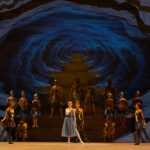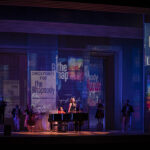National Technical Institute for the Deaf Theatre Uses Captions, Projections
Most hearing people never give the word “Earth” a thought, but to deaf people, it’s a word that starts with “ear”—proof that our planet is a world meant for people who can hear.
In Tales from the Deaf Side, a new play written by associate professor Aaron Kelstone, Ph.D., at the National Technical Institute for the Deaf at the Rochester (NY) Institute of Technology, characters tell the tale of “Eyeth,” an alternate planet on which communication by sign language is the norm. On Eyeth, no one understands why some people try to communicate using their mouths. A deaf man traveling to Eyeth from Earth rescues the hearing people and takes them back to Earth with him, where they can talk with others like them.

Kelstone’s play takes place in a rundown junkyard where Zak, played by Perseus McDaniel, tinkers with an old bus he hopes to take on the road someday. When four friends come to introduce him to Peachy, a newcomer to their neighborhood played by Wolfgang Staley, they all begin to tell stories, a number of which come from well-known folklore in the deaf community. The friends mingle expressive mime with American Sign Language to bring the tales to life.
Most NTID Theatre productions feature voice actors as well as a deaf cast, making the plays accessible to both a deaf and a hearing audience. Tales from the Deaf Side is performed without voice actors, however, so the play relies on captions projected onto the set to allow hearing audience members to follow the stories.

A Collaborative Set Design
Creating a set design with a prominent place for captions became the final exam project for the college’s Scenic and Lighting Technology class in spring 2016, taught by senior instructor Erin Auble, who also serves as scenic designer of NTID’s productions. Students submitted designs including a concept sketch, ground plan or front elevation, and full color visualizations of their design ideas, and defended their concepts to an audience of theatre professionals and professors.
Kelstone provided the class with a description of the set he imagined, a junkyard that “will open up creative use of various objects on the set to form the shape of each story. Part of the set could be some kind of frame that allows the actors to step up or down like a jungle gym, so they have different levels to work from during the show.”
The students set to work, discussing ideas in class and refining their initial ideas. “For the final, they spread out their work and defended their concepts, and people voted,” said Auble. ““We tallied it up and I had six students’ designs that morphed into the concept we used. I called myself the set design coordinator—the students were the designers.” The six students included Gabriella Buccieri, Gabriel Centi, Cullen Keath, Robert Phillips, Gregory Sabol and Rajbir Shokar.
Auble pulled together the final design, a fanciful vacant lot surrounded by a chain-link fence and walls tagged with bold, vibrant graffiti. “One student came up with the floor texture,” she said. “One came up with the graffiti. One had great research images, like a rundown shack in a meadow.”
The imaginative final set provided plenty of freedom of movement, as well as a wide range of objects to use in storytelling. “Honestly, I don’t think I would have gotten there without the students,” Auble added. “It’s their brains and their work. I’m very proud of them.”

Projections Finish the Job
The junkyard’s back walls became projection screens for moving images that helped illustrate the stories, as well as a wide area for captions. “Some of the students had already figured out the caption wall, and how to use a projected image so they could morph things,” said Auble. “Did we want the captions to be in the projected images, or do we want them to be a separate entity? In the end, we kept them separate.”
For projection designer Dan Roach, a show without voice actors was a first in his 15 years with NTID Theatre. “It felt different, even for me,” he said. “But you get closer to how a deaf person experiences the show.”
Projections aided the storytelling by adding literal images: a rocket ship taking off from Earth and landing on Eyeth, a bear rearing up on its hind legs as Zak tells a camping story. When it came to captioning what the actors were saying, however, the process became complicated. Normally a production has a complete script, so captions are simply a matter of inputting the script into the caption system. This time was different: The show came together fairly organically, with the student actors improvising to develop the stories and embellishing them in rehearsal. “I didn’t even know for sure what was in the second half of the show until four days before tech,” said Roach. “I knew it would be there later than normal, but I was glad they had time to develop it right up to the last minute.”
To accommodate the captions, Roach created a projection that matched the set’s physical walls. “It was the first time I actually put an image behind the text,” he said, noting that captions usually are projected at the top of a proscenium arch or on a screen separate from the set. “It’s not so stark. It softens it.”
Most importantly, incorporating the captions into the set allows the audience to continue to watch the action rather than directing their attention away from the show to read the caption. “The audience looks up at the captions a lot,” said Roach. “It’s good not to break them out of the show, to give them the same feel.”
It seems like the use of captions would be standardized for deaf theatre, Roach said, but he finds himself breaking new ground regularly. “The interesting thing is, there isn’t really a set convention on how to include captions in deaf theatre,” he said. “There’s a big discussion about what’s the best way to do this. A year ago, we did video screens onstage. They’re kind of frowning on that now, because people have to look up or down. Now we’re including them as part of the set. The technology is finally catching up to let us do new and different things.”
Randi Minetor is an author and freelance writer based in upstate NY.


